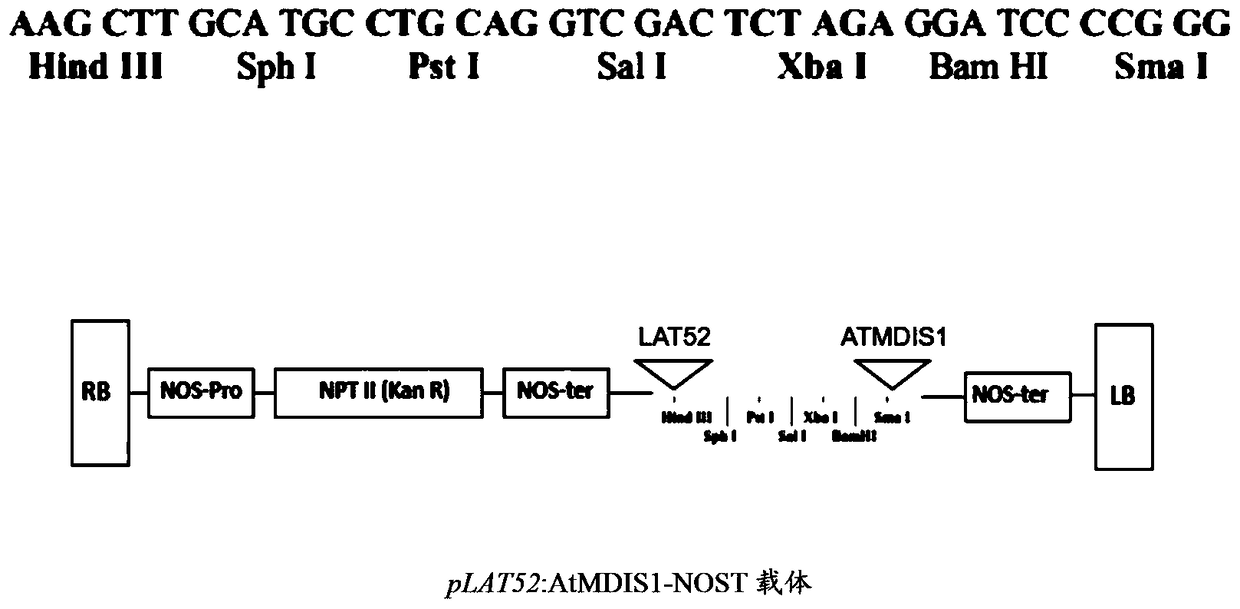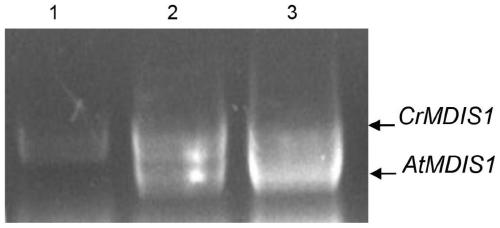The Lrr-RLK receptor kinase ATMDIS1 and its use in breaking reproductive isolation between species
A technology of reproductive isolation and species, applied in the biological field, can solve problems such as hybrid sterility, hinder gene exchange, and cannot use heterosis breeding to achieve the effect of improving efficiency and increasing fertilization efficiency
- Summary
- Abstract
- Description
- Claims
- Application Information
AI Technical Summary
Problems solved by technology
Method used
Image
Examples
Embodiment 1
[0034] Example 1. AtMDIS1 Transformation of Capsella rubella Positive Plants Screening and Identification of Gene Expression.
[0035] 1. Preparation of AtMDIS1 gene expression vector pLAT52:AtMDIS1-NOST driven by LAT52 promoter based on pBI101.
[0036] First, use the Arabidopsis genomic DNA as a template to amplify the DNA fragment of the AtMDIS1 gene with the nucleotide sequence shown in SEQ ID No.: 1, and the amplification primer is MDIS1-F1: TCCC CCCGGG ATGGGTTGTCGATGGAATCCAATT (SEQ ID No.: 4); MDIS1-R1: TCCC CCCGGG TTATGTAGCTTCAGAGGATAAGATCT (SEQ ID No.: 5) (the Xma I restriction site is underlined, and the 5' end of the restriction site is a protective base). The AtMDIS1 fragment was amplified from pollen with TOYOBOKOD Plus enzyme, and the amplified product was digested with Xma I and recovered; the pBI101 vector (available to the public from the Institute of Genetics and Developmental Biology, Chinese Academy of Sciences) was digested with HindⅢ and dephosphorylate...
Embodiment 2
[0044] Embodiment 2, test optimal Capsella rubella pollen germination medium Carry out Capsella rubella pollen germination test
[0045] Adjust the prepared pollen germination medium to pH 7.5, add Promega company's low-melting agarose (article number V2111) and cook in a water bath until the agarose is completely dissolved, and then place it in a small petri dish (3.2cm in diameter, Pour 1-2mL of culture medium into NEST company (Product No. GBD-35-15), and place it in a refrigerator at 4°C for 1-2 hours until it is completely solidified.
[0046] Spread wild-type Capsella rubella pollen evenly on the prepared medium under a dissecting microscope, put wet toilet paper under the small petri dish, and germinate in a constant temperature greenhouse for 8 hours and count the number of germinated pollen / total pollen ratio, to calculate the germination rate.
[0047] Table 1 explores the pollen germination efficiency statistics of the more optimized Capsella rubella pollen germina...
Embodiment 3
[0052] Example 3. Detection of the efficiency of pollen of AtMDIS1 transgenic plants entering mature unfertilized Arabidopsis ovules.
[0053] Arabidopsis thaliana and Capsella rubella were emasculated one day before flowering (use hybrid tweezers to peel off the petals of the unbloomed buds and remove all the anther filaments).
[0054] The pollen of Capsella rubella was pollinated to the unfertilized stigma. After 30 minutes, the stigma was cut off and placed flat on the pollen germination medium. After culturing for 8 hours, unfertilized ovules of Arabidopsis thaliana were placed near the pollen tube.
[0055] When cultured at 24°C for 12-14 hours, the efficiency of transgenic pollen tube orientation to ovules was observed under a Leica DM4000B LED fluorescent microscope.
[0056] Apply aniline blue staining solution (1% w / v aniline blue, SIGMA product number 415049), 100mM K 3 (PO 4 ) (Sinopharm Chemical Reagent Beijing Co., Ltd., pH 10.0), observed under ultraviolet lig...
PUM
 Login to View More
Login to View More Abstract
Description
Claims
Application Information
 Login to View More
Login to View More - R&D
- Intellectual Property
- Life Sciences
- Materials
- Tech Scout
- Unparalleled Data Quality
- Higher Quality Content
- 60% Fewer Hallucinations
Browse by: Latest US Patents, China's latest patents, Technical Efficacy Thesaurus, Application Domain, Technology Topic, Popular Technical Reports.
© 2025 PatSnap. All rights reserved.Legal|Privacy policy|Modern Slavery Act Transparency Statement|Sitemap|About US| Contact US: help@patsnap.com



